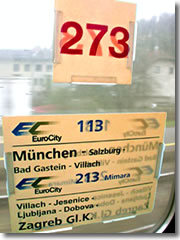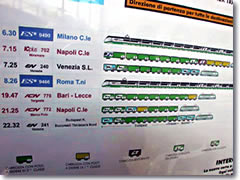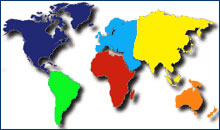More on European Train Stations
<< Back to the beginning the train station tips...
Finding your train (sometimes trickier than it sounds)
 The route cards posted in each train car list the start and end station of the line, along with major stops en route. In some cases, such as in this picture, the car—number 273—is going from Munich all the way to Zagreb, but it will be dong so as part of two different train lines. The train called "EC 113" goes from Munich to Villach, where it will probably join up with (or lose cars to) another train called "EC 213 'Mimara'," which makes the run from Villach to Zagreb. If you want to get to Zagreb and are sitting in this car, it doesn't really matter what the train's technically called before and after the station at Villach; you'll get where you're going anyway. Track assignments may change on a daily basis. In larger stations, check those big electronically updated departure boards. Then seek out a conductor on the indicated platform and blurt out your destination in a questioning voice while pointing at the waiting train for reconfirmation before boarding. Once on board, I also triple-check with passengers who look like they take this train every day.
The route cards posted in each train car list the start and end station of the line, along with major stops en route. In some cases, such as in this picture, the car—number 273—is going from Munich all the way to Zagreb, but it will be dong so as part of two different train lines. The train called "EC 113" goes from Munich to Villach, where it will probably join up with (or lose cars to) another train called "EC 213 'Mimara'," which makes the run from Villach to Zagreb. If you want to get to Zagreb and are sitting in this car, it doesn't really matter what the train's technically called before and after the station at Villach; you'll get where you're going anyway. Track assignments may change on a daily basis. In larger stations, check those big electronically updated departure boards. Then seek out a conductor on the indicated platform and blurt out your destination in a questioning voice while pointing at the waiting train for reconfirmation before boarding. Once on board, I also triple-check with passengers who look like they take this train every day.
Make sure you get on the right car, not just the right train. Each car may very well be splitting off down the line, uncoupled from the rest of the train at some junction station and then joined up to another train headed to an entirely different destination. Yes, this has happened to me before. (Actually, that's a big part of my job: screwing up so you can learn from my mistakes and do it right the first time.)
Even though a track number will be printed on that schedule poster, track assignments can change on a daily basis. In larger stations, check those big electronically updated departure boards for reconfirmation—but realize that those, too, can occasionally be wrong.
At any rate, getting on the right car is especially important when you're getting on a night train (if you have a reserved spot, you needn't worry). It's not hard to find the right car, though. Each car has its own destination placard, posted either in the window on the doors (as in the picture on the right picture), or slipped into a display plaque on the wall of the little entry/exit vestibule where the doors are.
There might be another kind of informative poster once you get to the train track itself (pictured below to the right). It shows you the composition of each train that regularly uses this track, including the locations of its numbered cars. A few seconds' perusal will give you have a sense of (a) where on the platform to wait for the car with your seat reservation, or more importantly (b) where the couchette cars are if you're planning to crash for free.
 These are not as prevalent as they once were, but on many station platforms there are wonderful signs that show you the composition of each train that regularly uses the track.
These are not as prevalent as they once were, but on many station platforms there are wonderful signs that show you the composition of each train that regularly uses the track.
For example, in the poster pictured (hard to reproduce on a tiny computer screen; you'll have to squint and/or just take my word for it here), the second-from-the-top train—the one headed to Napoli—has seven second-class cars (green), followed by a handicapped one (green with a wheelchair), a dining car (red), and then three first-class cars (yellow).
That one's easy. The bottom train to Budapest is more complicated. It's composed of a sleeper car (blue), a second-class couchette car, and four regular second-class cars (the type where you might be able to sleep for free) all going to Budapest (the names of these destinations are written under the train, hard to see in this tiny image, but trust me, they're there). Then there's a second-class car that will end up in Timisoara, followed by two sleeper cars at the end that are going to Bucharest.
This is the sort of vital information that can help you avoid ending up at the wrong end of Eastern Europe, arriving in the capital of Romania when you meant to go to the capital of Hungary.
Again, always check with the conductor and fellow passengers . You may look like an obsessive compulsive dweeb, but at least you won't end up on a train bound for Marseille when you meant to go to Venice.
Related Articles |
Outside Resources |
This article was last updated in October 2006. All information was accurate at the time.
Copyright © 1998–2010 by Reid Bramblett. Author: Reid Bramblett.



 ShareThis
ShareThis
